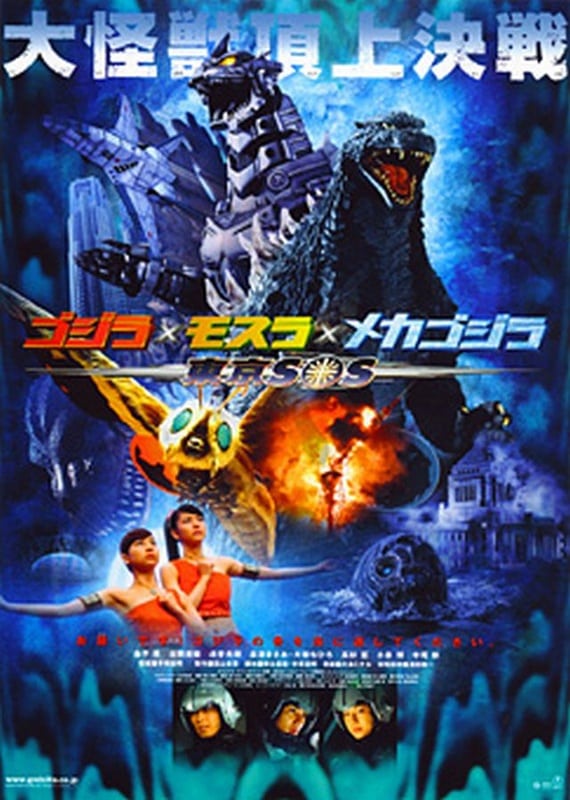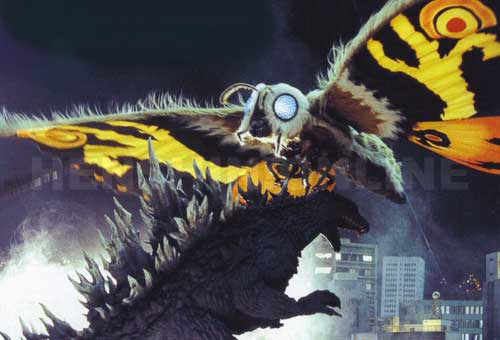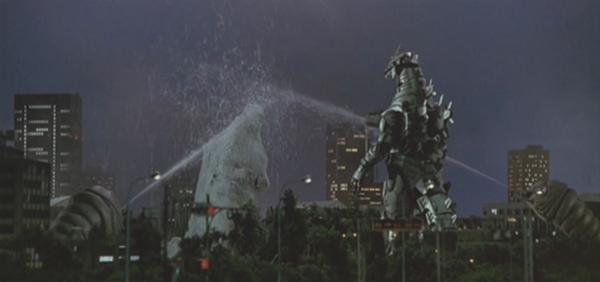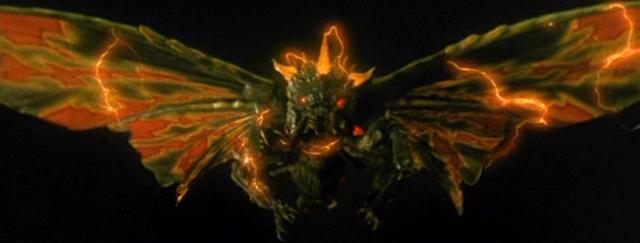Godzilla: Tokyo S.O.S. (2003)
Directed by: Masaaki Tezuka
Written by: Masaaki Tezuka, Masahiro Yokotani
Starring: Hiroshi Koizumi, Miho Yoshioka, Mitsuki Koga, Noboru Kaneko
HCF REWIND NO. 212: GODZILLA: TOKYO S.O.S. AKA GOJIRA TAI MOSURA TAI MEKAGOJIRA TOKYO ESU O ESU, GODZILLA, MOTHRA AND MECHAGODZILLA: TOKYO SOS [Japan 2003]
AVAILABLE ON DVD
FEATURED MONSTERS: GODZILLA, MECHAGODZILLA, MOTHRA, KAMOEBA [dead]
RUNNING TIME: 91 min
REVIEWED BY: Dr Lenera, Official HCF Critic
Mechagodzilla is undergoing repair modifications after its battle with Godzilla. The Prime Minister accepts Lead Scientist Yoshito Chujo’s choice to replace the Absolute Zero Cannon with a powerful Tri-Maser. Meanwhile the Shobijin, Mothra’s tiny twin fairies, warn the Japanese government that Godzilla continues returning to Japan because they used the original Godzilla’s bones in Kiryu’s design. If they return the bones to the bottom of the sea, Mothra would gladly take Kiryu’s place in defending Japan, but if they do not, Mothra will declare war on humanity. Soon enough, Kamoebas, a giant turtle, is found washed ashore on a Japanese beach, obviously killed by Godzilla, who is nearing Japan….
I had to chuckle while watching Godzilla: Tokyo S.O.S. It’s the 27th film in the Japanese franchise [for some inane reason I included the 1998 American travesty as a Godzilla film in my series of reviews], it’s been 1954 since the King of the Monsters first appeared onscreen to wreck havoc in Japan, and yet we still have men in monster suits smashing buildings and fighting. It’s actually great that they still contain the same ingredients, and do things, for the most part, the old-fashioned way, though the problem with Godzilla: Tokyo S.O.S. is that it’s little more than a rehash, chiefly of Mothra, Mothra Vs Godzilla and Godzilla Against Mechagodzilla, with precious little in the way of new ideas. Of course all Godzilla films copy earlier ones to differing degrees, but this one was obviously just made to keep the series going. That’s not to say it’s not fun though. One of the fastest paced Godzilla films ever, it delivers all the monster action a fan could want, which is why it’s one of the most sheerly enjoyable of the Millennium series, and contains the most consistently good special effects of any Godzilla movie, but just seems to be lacking somewhat in inspiration.
Godzilla: Tokyo S.O.S. is the only film in the Millennium series to be a direct sequel to the film that immediately proceeded it. The other films in this somewhat confused third series exist in their own universes, though some fans have tried to make sense of it all, which is a losing battle as far as I’m concerned! Masaaki Tezuka, the director of Godzilla Against Mechagodzilla, was asked to return for this film, and this time co-wrote the screenplay with Masahiro Yokotani who had co-authored the script for Godzilla, Mothra and King Ghidorah: Giant Monster’s All-Out Attack. It seems that producer Shogo Tomiyama controlled this film somewhat, insisting that the script was rewritten to make it more child-friendly, and getting the monster whose dead body washes up on the shore changed from the popular Anguirus to the more obscure Kamoeba, who had only previously appeared in only one film, 1970’s middling Space Amoeba. Hiroshi Koizuma reprised his role of Professor Shin’ichi Chûjô from the original Mothra,which he starred in 41 years earlier. Godzilla: Tokyo S.O.S. was a box office success, but not a major one. The fact that it only ranked third in the chart on its opening weekend was a clear indication that Godzilla’s popularity in Japan was diminishing somewhat, and still seems to be sadly.
It’s the return of the aged Chujo that gives Godzilla: Tokyo S.O.S. much of its interest at first, his delight at seeing the Shobijin again quite wonderful in a film which in a way is the most nostalgic Godzilla film in a very long time, though after a while the character has little to do. The opening action scene of planes tracking ‘something’ moving in some clouds is partly undone by the obviously CGI planes, but the shots of what turns out to be Mothra moving under the very convincing clouds are nicely done. The exposition of this film is somewhat rushed in order to get to the action, and once again we have a slightly awkward, geeky young scientist, here called Yoshito Chujo, as the hero, plus a tough yet vulnerable heroine and a cute kid. There are hints of a love triangle involving Yoshito , Azusa Kisaragi and Kyosuke Akiba, an arrogant Mechagodzilla operator, but it’s all but forgotten about after a while. There’s also a brief appearance from Akane Yashiro the heroine of Godzilla Against Mechagodzilla in a film whose attempts at continuity [it also, of course, links with Space Amoeba] are rather refreshing. The bonkers idea of bones that can remember is brought up again, plus the previous film’s themes of responsibility and real vs. artificial life are continued. In fact you could pretty much watch Godzilla Against Mechagodzilla and Godzilla: Tokyo S.O.S. together as one long film.
Mothra is briefly seen very early on in a shot copied from Mothra Vs Godzilla, and it’s not long before Godzilla appears to destroy a submarine. After about half an hour, the monsters take centre stage and the humans, at least the ones not inside Mechagodzilla, are virtually forgotten about, something which sometimes does occur in these films but not normally this quickly. It all becomes one long fight in sections. Godzilla fights and kills Mothra, then goes on to fight Mechagodzilla while Mothra’s egg hatches to the usual song [though we haven’t heard it so far in the Millennium series] and, as in Mothra Vs Godzilla, Mothra’s egg hatches and two twin Mothra larvae head straight for Tokyo to avenge their mother’s death, meaning that you just know you’re going to get a reply of the climax of the 1964 classic, only this time in the middle of the city and with Mechagodzilla sometimes joining in. While it never reaches a higher level of excitement, the huge amount of kaiju battling doesn’t get tiresome because the fights, even if they do copy shots [the King Kong Vs Godzilla body flip is employed yet again] used before, are well staged and agile without often seeming ridiculous. One fabulous moment has Mothra land on top of Godzilla’s back and shove him into a bridge. Meanwhile Yoshito gets a frantic motorbike dash into the Tokyo underground, and it all ends with the not-used-for-a-while situation of two monsters falling into the sea and yet another climactic self-sacrifice by a human, though in Marvel fashion there’s a post credits scene which shows us that humans certainly haven’t learnt the lessons sometimes preached to us by the proceeding 91 min.
Godzilla looks the same as before, while Mechagodzilla is almost the same but now has a Mazer gun on his chest and improved wrist missiles which can go round a skyscraper if they’re intended to hit Godzilla. Mothra, who has barely been altered since 1960, looks almost as good as she did in 1992, though her wings don’t flap as often as they should when she’s flying. A variation on her 1964 yellow dust weapon returns in the form of golden scales. The CGI is much improved overall, most notably when Godzilla destroys the submarine, though there are too many occasions when a plane or some other flying CGI thing is hurled at the viewer. This was no doubt intended to be a cool device but only emphasises the fakery. Still, generally the effects, by newcomer Eiichi Asada, are superb. The matting is smooth, the models are detailed, the pyrotechnics are spectacular – in fact this film should be shown to those fools who still think that Godzilla movies have crap effects. The Shobijin scenes are especially well executed, in fact they’re nearly flawless as long as you ignore the fact that the two girls don’t look at all like twins [nor do they look like the ones in Mothra as seen as a flashback]and now apparently live on a place called Himago Island, not Beiru Island or Infant Island. The whole Mothra element comes across as less mystical and beautiful than usual, perhaps because so much in the film is rushed, seemingly so that the kids whom this one, out of all the Millennium films, seems most aimed at, don’t get bored. Godzilla: Tokyo S.O.S. sometimes feels like a child’s version of a Godzilla film, drawing from memories of older films and refining them into a far simpler mindset, though it lacks the great quirkiness of some of the Showa juvenile entries like Son Of Godzilla and Godzilla Vs Gigan.
Tezuka again delivers a really tight film and cinematographer Yoshinori Sekiguchi sometimes gives us some interesting angles during the action. The acting, apart from Koizumi, is mostly average and Miho Yoshioka is quite weak, though she’s also gorgeous, which helps. Michiru Oshima’s score repeats her Godzilla and Mechgodzilla themes from Godzilla Against Mechagodzilla, adds a decent Mothra theme and some lovely slow tracks for the occasional spots in the film when there’s room for them, most notably a poignant piece which is heard in full during the end credits. She sometimes seems to be trying to get to the heart of Godzilla: Tokyo S.O.S., though to be honest it only occasionally shows that it has one, unlike Godzilla Against Mechagodzilla which had an interesting emotional dimension throughout. It’s concerned primarily with monsters smashing stuff and having fights, and that’s just fine for a Godzilla film – it’s primarily why I watch them – though some new ideas would have helped, and it seems to live too much in the franchise’s past, rather than its present. Still, it’s big, loud and, if not quite dumb [quite a few of these films are actually far more intelligent than most Hollywood effects-filled blockbusters and have real messages to them], perfect relaxation fodder.










Be the first to comment